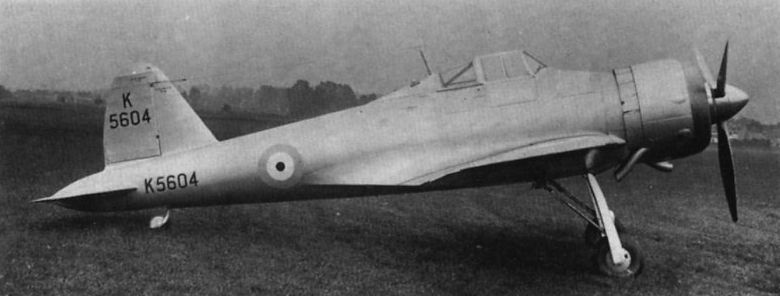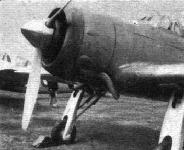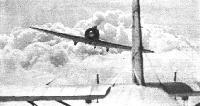
Gloster F.5/34
Последним истребителем фирмы "Gloster", спроектированным Генри Фолландом перед уходом с фирмы, стал прототип самолета Gloster F.5/34, названного так по номеру технического задания Министерства авиации. Именно по этой спецификации на разработку одноместного истребителя с мощным вооружением были созданы такие знаменитые самолеты, как Hawker Hurricane и Supermarine Spitfire.
Созданный Фолландом совместно со своим коллегой Г.Е. Престоном, Gloster F.5/34 представлял собой свободнонесущий низкоплан цельнометаллической конструкции, за исключением рулевых поверхностей, имевших обшивку из полотна. Шасси с хвостовым колесом было убирающимся. В качестве силовой установки использовался радиальный двигатель Bristol Mercury IX, а пилот сидел в кабине, закрывавшейся сдвижным фонарем. Вооружение самолета состояло из восьми пулеметов Browning, установленных в крыле, вне зоны, ометаемой винтом.
Постройка прототипа (K5604) шла с большими задержками из-за загруженности фирмы выпуском истребителей Gauntlet и Gladiator, и он поднялся в воздух лишь в декабре 1937 года. Второй прототип (K8089) взлетел в марте 1938 года. К этому времени F.5/34 уже не имел шансов на запуск в серию, так как на вооружение были приняты истребители Hurricane и Spitfire.
ТАКТИКО-ТЕХНИЧЕСКИЕ ХАРАКТЕРИСТИКИ
Gloster F.5/34
Тип: одноместный истребитель
Силовая установка: один 9-цилиндровый радиальный двигатель Bristol Mercury IX мощностью 840 л. с (626 кВт)
Летные характеристики: максимальная скорость на высоте 4875 м - 509 км/ч; потолок 9905 м
Масса: пустого 1901 кг; максимальная взлетная 2449 кг
Размеры: размах крыла 11,63 м; длина 9,75 м; высота 3,10 м; площадь крыла 21,37 мг
Вооружение: восемь 7,7-мм пулеметов Browning
- Описание
Фотографии
-
Air International 1983-01
Регистрационный номер: K5604 [15] One of a series of "round-the-clock" ground views of the Gloster F.5/34 taken by the Air Ministry photographer in accordance with the standard requirement; almost certainly taken immediately before or at the time of first flight, these official prints are dated May 1937.
-
Flight 1937-06 / Flight
Регистрационный номер: K5604 [15] FLEDGED: The eagerly awaited Gloster multi-gun monoplane fighter, which, judging by appearances, should occupy an extremely small period of time in getting from x to y at the behest of the Mercury or the sleeve-valve Perseus, which are its alternative power plants. Note the forward position of the fin and rudder relative to the tail plane.
-
Aviation Historian 11 / R.Pegram - Folland's Forgotten Monoplanes (3)
Регистрационный номер: K5604 [15] The first of Gloster’s monoplane fighters to fly and the last of Folland’s designs for the company, the F.5/34 made its first flight in December 1937. Only two prototypes were built; K5604, as seen here, and K8089, which first flew in March 1938, by which time Sydney Camm’s superior Hurricane was already in squadron service.
The Gloster F.5/34 was akin to a monoplane version of the Gladiator and was powered by an 840 h.p. geared and supercharged Mercury IX enclosed in a long-chord cowling with controllable cooling gills. The aircraft was a rival to the Spitfire and Hurricane and - unsurprisingly - was never put into production. -
Flight 1937-06 / Flight
Регистрационный номер: K5604 [15] GLOSTER'S LATEST: A three-quarter-front aspect of the new monoplane fighter. Leading dimensions are: Span, 38ft. 2in.; length, 31ft. 1in.; height, 10ft. 1in.
-
Air Enthusiast 2006-09 / A.Ord-Hume - Folland's Civil Side /Paper planes/
Регистрационный номер: K8089 Folland's last design for Gloster was the F5/34 fighter, which first flew in December 1937.
-
Flight 1937-12 / Flight
Fairly typical of a modern single-row installation is the Mercury in the Gloster F.5/34 fighter. The crankcase cowl is not standard.
-
Flight 1940-04 / Flight
Регистрационный номер: K5604 [15] -
Aviation Historian 10 / R.Pegram - Folland's Forgotten Monoplanes (2)
Регистрационный номер: K5604 [15] Significant in being the first Gloster monoplane to fly, the first F.5/34 climbs away from Hucclecote some time after its maiden flight in December 1937. Two examples were built, K5604 and K8089, but although the type showed a good deal of promise, its thunder was comprehensively stolen by the advent of the Spitfire and Hurricane.
-
Flight 1937-06 / Flight
Регистрационный номер: K5604 [15] The new Gloster multi-gun fighter monoplane fitted, at the moment, with a Bristol Mercury engine.
-
Jane's All the World Aircraft 1938 / 03 - All the world's aeroplanes
Регистрационный номер: K5604 [15] The Gloster F.5/34 Single-seat Multi-gun Fighter Monoplane (Bristol "Mercury IX" engine).
-
Aviation Historian 11 / R.Pegram - Folland's Forgotten Monoplanes (3)
Регистрационный номер: K5604 [15] -
Мировая Авиация 140
Регистрационный номер: K5604 [15] Техническое задание, по которому были созданы истребители Hawker Hurricane и Supermarine Spitfire, привело также к появлению и Gloster F.5/34, имевшего неплохие летные данные, но безнадежно опоздавшему.
-
Air International 1983-01
Регистрационный номер: K5604 [15] One of the series of photographs of the Gloster F.5/34 in "The Aeroplane" series numbered 10.121
-
Flight 1937-11 / Flight
Регистрационный номер: K5604 [15] The Flight photograph of the newest British single-seater multi-gun fighter - the Gloster F.5/34 with Bristol Mercury engine.
The shapely Gloster F.5/34 is characterised by an unusual tail in which the fin and rudder are placed well forward. -
Flight 1938-08 / Flight Advertisements
Регистрационный номер: K5604 [15] THE GLOSTER MONOPLANE FIGHTER: with “Bristol” Mercury engine. A single-seat, multi-gun, day and night fighter of low-wing, metal, stressed-skin construction. Fitted with retracting undercarriage, two-position 3-bladed airscrew, and fully-enclosed and heated cockpit. Span, 38 ft.; length, 32 ft.; height, 10 ft.; wing area, 230 sq. ft. An extremely fast and manoeuvrable machine, of which no performance details are available for publication. Built by the Gloster Aircraft Co. Ltd.
-
Flight 1937-07 / Flight
Регистрационный номер: K5604 [15] -
Flight 1937-07 / Flight
Регистрационный номер: K5604 [15] The Gloster F.5/34 single-seater fighter is one fine example of 1937 military prototypes. The Gloster was designed for a Mercury or Perseus radial.
-
Flight 1937-06 / Flight
BACKGROUND: The latest of a long and brilliant line of Gloster fighters, the new multi-gun monoplane is designed to take a Bristol radial. A Mercury is installed in the prototype, seen here looking in on Hawker's "-MR," but a sleeve-valve Perseus may later be substituted.
-
Aviation Historian 10 / R.Pegram - Folland's Forgotten Monoplanes (2)
The design by Folland and Howard Preston to Specification F.5/34 was the first of Folland’s monoplane fighters and the last of his Gloster designs to fly. Echoes of its shape and layout would surface in the E.28/39 jet, a product of Folland’s successor, George Carter.
- Фотографии



















